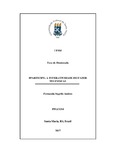| dc.creator | Andres, Fernanda Sagrilo | |
| dc.date.accessioned | 2018-04-27T13:51:19Z | |
| dc.date.available | 2018-04-27T13:51:19Z | |
| dc.date.issued | 2017-03-10 | |
| dc.identifier.uri | http://repositorio.ufsm.br/handle/1/13083 | |
| dc.description.abstract | We live in the era of media convergence and, in this moment, television, cellphone and computers break barriers and are used simultaneously in the same tv production. Taking as the start point the role of TV in face of this new reality established for other devices and platforms, this study seeks to investigate the phenomenon of interactivity between broadcaster and public that contaminates the audiovisual production in Brazil. Focusing on the three seasons of the program Master Chef and the program Superstar, broadcasted by Globo Teve and Televisão Bandeirantes, this study proposes examine the pratices headed by these TV producers to try to creat interactivity with their viewer/user and the resulting texts (second screen) to verify its repercursion and implications. The research utilize theorical-methodological contributions of the European semiotics inaugurated by Greimas with the complements formulated by his followers, especially the concept of interative practice brought by Ladowski. In the methodological approach, the research contains the interactive practice corresponding to the interactivity regime proposed to the viewer / user by the programs and the text that result from this action, which implies the examination of their paratextual, intertextual and intratextual instances in order to recognize the forms of participation proposed in the programs and the levels of interactivity prevailing in broadcasters. | eng |
| dc.description.sponsorship | Conselho Nacional de Pesquisa e Desenvolvimento Científico e Tecnológico - CNPq | por |
| dc.language | por | por |
| dc.publisher | Universidade Federal de Santa Maria | por |
| dc.rights | Attribution-NonCommercial-NoDerivatives 4.0 International | * |
| dc.rights.uri | http://creativecommons.org/licenses/by-nc-nd/4.0/ | * |
| dc.subject | Estratégia | por |
| dc.subject | Interatividade | por |
| dc.subject | Mídia televisual | por |
| dc.subject | Mídia televisual | por |
| dc.subject | Prática interativa | por |
| dc.subject | Texto de segunda tela | por |
| dc.subject | Strategy | eng |
| dc.subject | Interactivity | eng |
| dc.subject | TV media | eng |
| dc.subject | Interactive practice | eng |
| dc.subject | Second screen text | eng |
| dc.title | #Participe: a interatividade do fazer televisual | por |
| dc.title.alternative | #Participate: the interactivity of the televisual | eng |
| dc.type | Tese | por |
| dc.description.resumo | Vive-se a era da convergência midiática, momento em que televisão, telefone celular e computador abandonam as barreiras para serem empregados de maneira simultânea, em uma mesma produção televisual. Este estudo, tomando como ponto de partida o papel da televisão frente a essa nova realidade oferecida por outros dispositivos e plataformas, busca investigar o fenômeno da interatividade, entre emissora e público, que contamina o fazer televisual no país. Assim, centrado nas três temporadas dos programas SuperStar e MasterChef, veiculados, respectivamente, pela Televisão Globo e pela Televisão Bandeirantes, propõe como objetivo o exame das práticas encabeçadas pelas emissoras, na tentativa de criar interatividade com o telespectador/usuário, e dos textos daí decorrentes (segunda tela), para verificar suas repercussões e implicações. No plano conceitual, o trabalho convoca os aportes teórico-metodológicos da semiótica de linha europeia, inaugurada por Greimas, com as complementações formuladas por seus seguidores, em especial a noção de prática interativa, trazida por Landowski. No encaminhamento metodológico, a investigação contempla a prática interativa, correspondente ao regime de interatividade proposto ao telespectador/usuário pelos programas, e o texto resultante dessa ação, o que implica o exame de suas instâncias paratextual, intertextual e intratextual, com vistas a reconhecer as formas de participação propostas nas emissões e os níveis de interatividade predominantes nas emissoras. | por |
| dc.contributor.advisor1 | Castro, Maria Lilia Dias de | |
| dc.contributor.advisor1Lattes | http://lattes.cnpq.br/8927752518456308 | por |
| dc.contributor.referee1 | Médola, Ana Sílvia Lopes Davi | |
| dc.contributor.referee1Lattes | http://lattes.cnpq.br/4868421701118971 | por |
| dc.contributor.referee2 | Carvalho, Cristiane Mafacioli | |
| dc.contributor.referee2Lattes | http://lattes.cnpq.br/5911643565657962 | por |
| dc.contributor.referee3 | Duarte, Elizabeth Bastos | |
| dc.contributor.referee3Lattes | http://lattes.cnpq.br/3200128190656063 | por |
| dc.contributor.referee4 | Barichello, Eugenia Maria Mariano da Rocha | |
| dc.contributor.referee4Lattes | http://lattes.cnpq.br/1075373845442641 | por |
| dc.creator.Lattes | http://lattes.cnpq.br/2911718771692454 | por |
| dc.publisher.country | Brasil | por |
| dc.publisher.department | Comunicação | por |
| dc.publisher.initials | UFSM | por |
| dc.publisher.program | Programa de Pós-Graduação em Comunicação | por |
| dc.subject.cnpq | CNPQ::CIENCIAS SOCIAIS APLICADAS::COMUNICACAO | por |
| dc.publisher.unidade | Centro de Ciências Sociais e Humanas | por |



